- Home
- Nancy Mitford
Voltaire in Love
Voltaire in Love Read online
NANCY MITFORD (1904–1973) was born into the British aristocracy and, by her own account, brought up without an education, except in riding and French. She managed a London bookshop during the Second World War, then moved to Paris, where she began to write her celebrated and successful novels, among them The Pursuit of Love and Love in a Cold Climate, about the foibles of the English upper class. Mitford was also the author of four biographies: Madame de Pompadour (1954), Voltaire in Love (1957), The Sun King (1966), and Frederick the Great (1970)—all available as NYRB Classics. In 1967 Mitford moved from Paris to Versailles, where she lived until her death from Hodgkin's disease.
ADAM GOPNIK has been a staff writer at The New Yorker since 1987, writing often on French life and literature. His many books include Paris to the Moon, an anthropology of modern French manners, and The Table Comes First, an essay on the philosophy of eating. He has also written introductions to new editions of works by authors such as Balzac, Alain-Fournier, Hugo, and Maupassant. In 2012, Gopnik was made a Chevalier de l’Ordre des Arts et des Lettres of France.
OTHER BOOKS BY NANCY MITFORD
PUBLISHED BY NYRB CLASSICS
Frederick the Great
Madame de Pompadour
The Sun King
VOLTAIRE IN LOVE
NANCY MITFORD
Introduction by
ADAM GOPNIK
NEW YORK REVIEW BOOKS
New York
THIS IS A NEW YORK REVIEW BOOK
PUBLISHED BY THE NEW YORK REVIEW OF BOOKS
435 Hudson Street, New York, NY 10014
www.nyrb.com
Copyright © 1957 by Nancy Mitford
Introduction copyright © 2012 by Adam Gopnik
All rights reserved.
First published in Great Britain by Hamish Hamilton, 1957
Cover image: Jean-Honoré Fragonard, Cupid and Psyche; © RMN-Grand Palais / Art Resource, NY
Cover design: Katy Homans
The Library of Congress has cataloged the earlier printing as follows:
Mitford, Nancy, 1904–1973.
Voltaire in love / by Nancy Mitford; introduction by Adam Gopnik.
p. cm. – (New York Review books classics)
Includes bibliographical references and index.
ISBN 978-1-59017-578-1(alk. paper)
1. Voltaire, 1694–1778—Relations with women. 2. Du Châtelet, Gabrielle
Émilie Le Tonnelier de Breteuil, marquise, 1706-1749.3. Authors, French—
18th century—Biography. 4. Scientists—France—Biography. 5. Mistresses—
France—Biography. I. Title.
PQ2103.D7M52012
848'.5O9—dc23
[B]
2012019447
ebook ISBN: 978-1-59017-593-4
v1.0
For a complete list of books in the NYRB Classics series, visit www.nyrb.com or write to:
Catalog Requests, NYRB, 435 Hudson Street, New York, NY 10014
Contents
Biographical Notes
Title Page
Copyright and More Information
Introduction
VOLTAIRE IN LOVE
Dedication
Acknowledgements
Author’s Note
1. Voltaire and Émilie
2. The Young Voltaire
3. Voltaire in England
4. Émilie Inherits Voltaire
5. The Richelieu Wedding
6. Cirey
7. ‘Les Amours Philosophiques’
8. Frederick Appears on the Scene
9. Exit Linant, Enter Mme Denis
10. The Battle of Desfontaines
11. Mme de Grafigny’s Story
12. Various Journeys
13. Frederick Comes to the Throne
14. Voltaire Fails for the Académie Française
15. Voltaire and Frederick
16. A Happy Summer at Cirey
17. Voltaire at Court
18. The Philosophers in Bad Odour
19. An Invitation
20. Lunéville
21. ‘Sémiramis’
22. Miscellaneous Works
23. ‘C’est vous qui me l’avez tuée’
Epilogue
Bibliography
Index
Introduction
Voltaire in Love, first published in 1957, is Nancy Mitford’s retelling of the story of the fifteen-year-long love affair between Voltaire, the dominant writer of the European eighteenth century (“No man has ever had so much fame in his lifetime as Voltaire,” said Dr. Johnson, no admirer), and the Marquise du Châtelet, known as Émilie, an aristocrat who by an exemplary act of will made herself an important scientist and philosopher at a time when women were not expected to be either and were most often mocked when they managed it.
Mitford’s story is really two stories: One tells how Voltaire and Émilie worked together, mostly at her château in Cirey (with her patient, cuckolded husband in odd, spare-bedroom attendance), to bring Newtonian science to Cartesian France, producing both scientific papers and a masterpiece of popular explanation, her translation of Newton’s Principia. The other, counterpointed story tells of how they came, truly, to love each other—a love at least briefly of the body as well as of the mind and soul, and how that love worked its twisted, original, difficult way to a decent, amiable conclusion in friendship. It’s a relationship that anticipates many other love affairs in succeeding centuries between smart spoiled men and bright difficult women. “That lady whom I look upon as a great man,” Voltaire wrote of her. “She understands Newton, she despises superstition and in short she makes me happy.” George Eliot and George Henry Lewes, Chopin and George Sand, J. S. Mill and Harriet Taylor—all those other love affairs where mind and body got twisted together in a pretzel of passion and philosophy are prefigured in this first one.
That sounds quite grand, but when Nancy Mitford decided to tell their story grand was the last thing she made it seem. Voltaire in Love was one of a series of popular histories of French figures that Mitford wrote for a mostly English, and then later American, audience after her arrival in Paris during the 1950s, where she lived at 7 rue de Monsieur, in the heart of the Faubourg Saint-Germain. She had come to live in France in order to be near her “Colonel,” Gaston Palewski, a brave Gaullist whom she had met in London during the war. She was madly in love with him, and he, more sporadically, was in love with her. Installed in France with an existing reputation for madcap, borderline Wodehousian novels about her bizarre upbringing as an aristocratic Englishwoman, she began to earn a living by writing popular books of French history. She wrote books about Madame Pompadour and Louis XIV and, here, about Voltaire. (A small literary tribute: I made my own image of Mitford in Paris into the heroine of my adventure story The King in the Window, in the person of Mrs. Pearson, and gave her the same Paris address.)
Mitford’s books about France were offered, and patronized by critics, as “pop history,” drawn from what academic historians call, primly, “secondary sources,” that is, accounts by other historians. This is a practice that sounds easy and is in its way as hard as archival research, since it involves selection and decisive reshaping from a literature already overabundant—topiary trimming rather than spadework. She recognized Voltaire himself as a master of this kind: “He thought that an historical study should be composed like a play, with a beginning, a middle and an end, not a mere collection of facts: ‘If you want to bore the reader, tell him everything.’”
The play she chooses to put on is a comedy, at times a farce. Her Voltaire, and to a lesser degree her marquise, are mostly ludicrous in their relation with each other and often ridiculous in their appearances in the world. Mitford’s Voltaire is genuinely in love, and, after his forced soj
ourn in London in the 1720s, really did see that Newton’s grand, universe-spanning physics had an explanatory power that Descartes’s alternative physics, dominant in France, with its cosmic “whirlpools” and “vortices,” lacked. (Though, as Mitford shrewdly remarks, Voltaire’s liking for English politics, liberal at least compared with French autocracy, and his desire to shake up his countrymen’s fatal complacency, had something to do with this apostasy.)
But his actions in this book are taken up less in watching the stars and calculating their paths than in the furious pursuit of his literary enemies here on earth, and mostly in Paris. Detailed accounts of long-forgotten literary conspiracy and vendetta, at once remote in their particulars and entirely familiar in their shape, fill the book: Voltaire gets engaged in squabbles with a now forgotten writer and editor, the Abbé Desfontaines, whom he thought a monster of ingratitude and a “sodomite” besides, feeds his own publisher with work that he is later outraged to see in print, libels other writers mercilessly, and then shrieks with rage—and even goes to law—when he is libeled and mocked in turn. Chapter 10 alone gives a perfect picture of the bewildering, incestuous, farcical feuding that still remains a constant of French intellectual life: Mme. du Châtelet writes a letter to Mme. de Champbonin asking for her support in Voltaire’s latest literary war, and she in turn writes to The-riot, who pities Voltaire but refuses to sign his petition, and, it turns out, is, shockingly, going to publish his own letter to Mme. du Châtelet in a competing paper run by the Abbé Prevost. “More rivers of mingled ink and tears flowed to Paris from Cirey” is Mitford’s dry comment.
Mitford understood the life that ran on the banks of this “river of mingled ink and tears” as well as any outsider to it ever has; she grasped the exasperating, irresistibly tiny nature of much French intellectual life. Yet she also saw that those little village fires could cast a global light. For her point throughout is that the pettiness and even occasional maliciousness of Voltaire’s nature was no bar to the seriousness of his achievement. Mitford understood—partly by instinct, partly by firsthand experience of a Faubourg Saint-Germain social life that had not really changed all that much since the eighteenth century—that the things that make Voltaire and the marquise seem petty were inextricably part of what made them great. Where more conventional historians try to race us past the drawing room (and the bedroom) toward the library and the laboratory, Mitford grasped that the silliness and the sublimity (and the sex) were all linked. Voltaire in love helped light the world.
There are, to be sure, very big things at stake in this book. Though Voltaire’s life with Émilie predates his days as a dissident and human rights campaigner, their advocacy of Newton’s physics was, intellectually, at least as courageous. Indeed, bringing Newton to France was a more formidable challenge than Mitford, no scientist herself, quite grasped, since Newton’s system, with its theory of gravitation demanding instant invisible action at enormous distances, in many ways looked to the French “occult,” where Descartes’s omnipresent “vortices” (Mitford calls them, nicely, “whirlpools”) were, though invisible, still mechanical, with each one physically touching the next, like cogs in clockwork wheels, from here on to eternity. Newton’s physics were a challenge not just to Gallic pride but to French logic. Yet the lovers struggled and succeeded in making these strange English ideas not merely lucid but even, in their way, fashionable. (Modern scholarship has helped us to see more clearly that it was the marquise who had much the deeper grasp of the physics and was much the more active intellectual principle of the pair.) Voltaire and Émilie demonstrated to France that the scientific imagination could be part of the social imagination, one more thing you wrote about to friends and talked about at dinner, and that this might be the best way to make converts to the cause of English-style experimental empiricism (and by implication to the English style of parliamentary politics).
This mix of a dream of Arcadian love with the pursuit of scientific experiment had long been part of the fantasy-fabric of French literature. The ancient, sly philosophe Bernard le Bovier de Fontenelle, who makes a couple of cameo appearances in this book, had already published in 1686 his beautiful Conversations on the Plurality of Worlds, in which a fictional marquise and her lover-instructor take on the difficult scientific doctrine of the “plurality of worlds”—quite as difficult as, and very similar to, today’s string-theory doctrine of the multiverse of many hidden dimensions—and manage to arrive at both an affair and an understanding. Voltaire and Émilie took this poetic dream and realized it as no lovers had before. Passionate themselves, they made what they pursued seem passionate and human. They made Newton seem exciting. The intimacy of their address is part of the intensity of their achievement.
The tone of Mitford’s book suggests this thought with the lightness of touch the thought demands. Her book is unapologetically full of gossip—on the homosexual nature of Frederick’s court, the mistresses of Louis XV. It’s also unashamedly full of the details of decor. Mitford quotes at length a memorable, contemporary account of the rooms where the marquise did her Newtonian experiments:
. . . a tiny boudoir, one could fall on one’s knees it is so pretty, panelled in blue with a ceiling by a pupil of Martin who has been working here for the last three years. Each panel has a picture by Watteau. There is a chimney-piece with brackets by Martin, which have pretty little things on them, and an amber ink stand sent with some verses by the Prince of Prussia.
Voltaire in Love still stands as a portrait of the French Enlightenment as it really was, with intrigue and idealism in strange but fizzy solution. Why did Nancy Mitford have the insight into the nature of French intellectual life denied to so many others? Many English people live for a long time in France, and though they often love it, they rarely “get it” in quite this way. It may be significant that all of the Mitford girls had to go elsewhere to find an identity. Aristocrats raised aristocratically, they “took” better elsewhere than in England: Unity pitifully and horribly in Germany, Jessica in America. France saved Nancy, much the best pure writer of the sisters. She grasped, and sets out here in exquisite detail, the other side of the constant vendettas and intrigues of Parisian life. She saw the workings of a society rooted in a set of manners designed, at whatever cost in truthfulness, on making other people feel comfortable and valued, a set of manners based on compliments and what the English call “affectations.” For every conspiracy Voltaire enters into against an enemy, he offers some extravagant compensatory compliment to a friend. (His enemies get them, too, when it’s tactically worthwhile.) This is not at all the English way, where the aim always seems, to this outsider at least, gleefully to create the maximum sense of social discomfort at every moment for the other guy, even if the other guy or girl is a friend. “But you look ravishing,” a modern marquise says when a mother with a newborn child comes looking haggard to the Paris drawing room, and she means it. “Nursing mothers have the most beautiful skin: the fullness of your bosom would look insipid if you were as naïvely beautiful as you were before.” And not only does the nursing mother feel more reassured, she feels that she is interesting. (“Yes. You do look peaked,” is the English equivalent.) Once, I heard one of the heirs of Voltaire return a toast at a New York dinner party. “You are not friends—you are my brothers and my sisters!” he announced to the puzzled room. A month or so later an English novelist of similar stature was feted at the same table “It’s someone’s turn every week to sit here and be toasted, and I’m glad this week it’s mine,” said the English novelist, half rising and then sitting down as he spoke. It’s easy to see which model, candor to the point of discomfort or courtesy to the point of absurdity, is likely to make for sharper satiric fiction—but it’s also easy to see which makes for a more enviable civilization.
It is her ability to draw and appreciate this civilization that makes Mitford almost alone among English writers. In her vision of the French Enlightenment, Voltaire’s compliments can be as extravagant as his conspiracies, an
d serve the same end: making social life into a constant theater of excitements, marked by that interchange of ideas and views and passions that, as Jürgen Habermas still insists, is what made the French Enlightenment matter. The idea of human liberty and the rights of man are inextricably tied up with the practice of backbiting and venting and writing duplicitous letters to apparent friends. Yet—and this is perhaps the crucial thing—where in the despotic world judgment takes the form of physical suffering, in the new world that this book inhabits condemnations are only words. The torrent of bitter words is comic because nobody is going to die from them. For all the bitterness they induce, they are still just words on paper—and choosing mock violence over real violence is exactly what it means to be enlightened.
Voltaire in Love is a small-scale masterpiece of antiheroic history. The two lovers live here. They were silly, petty, adolescent, impulsive, self-deluding, took absurd revenges for imagined wrongs, and lived lives of privilege and luxury; they were also wise, sublime, adult, saw much farther than their contemporaries, and helped advance the human spirit. Judith Zinser’s fine, recent biography of the marquise was given the slightly too-prim editorial subtitle: “From a Life of Frivolity to the Life of the Mind.” Nancy Mitford’s book reminds us that while it is always the purpose of pedantry to expand that difference, the purpose of a civilization is to reduce it until it becomes too small to see.
—ADAM GOPNIK
VOLTAIRE IN LOVE
To
Victor Cunard
Innumerable high-dressed gentlemen are gone to inorganic powder, no comfortable or profitable memory to be held of them more; and this poor Voltaire, without implement except the tongue and brain of him, he is still a shining object to all the populations and they say and symbol to me: ‘Tell us of him, he is the man.’

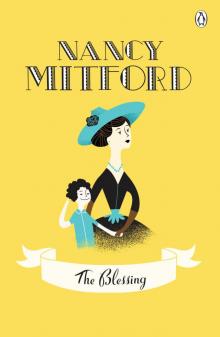 The Blessing
The Blessing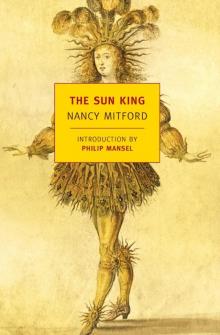 The Sun King
The Sun King Wigs on the Green
Wigs on the Green Love in a Cold Climate
Love in a Cold Climate The Penguin Complete Novels of Nancy Mitford
The Penguin Complete Novels of Nancy Mitford The Pursuit of Love
The Pursuit of Love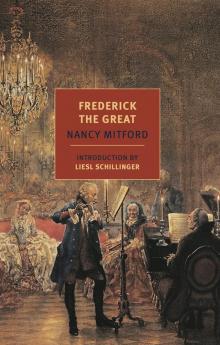 Frederick the Great
Frederick the Great Highland Fling
Highland Fling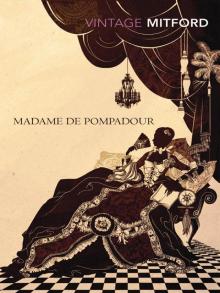 Madame de Pompadour
Madame de Pompadour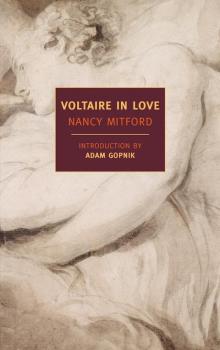 Voltaire in Love
Voltaire in Love Don't Tell Alfred
Don't Tell Alfred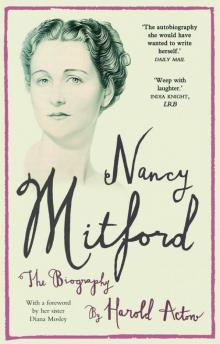 Nancy Mitford
Nancy Mitford Christmas Pudding and Pigeon Pie
Christmas Pudding and Pigeon Pie